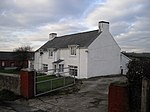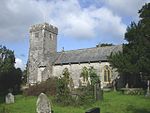St Lythans burial chamber

The St Lythans burial chamber (Welsh: Siambr Gladdu Llwyneliddon) is a single stone megalithic dolmen, built around 4,000 BC as part of a chambered long barrow, during the mid Neolithic period, in what is now known as the Vale of Glamorgan, Wales. It lies about half a mile (1 km) to the west of the hamlet of St Lythans, near Dyffryn Gardens. It also lies around one mile (1.6 km) south of Tinkinswood burial chamber, a more extensive cromlech that it may once have resembled, constructed during the same period. The site is on pasture land, but pedestrian access is allowed and is free, with roadside parking available for 2–3 cars about 50 yards (50 metres) from the site. The dolmen, which has never been fully excavated, is maintained by Cadw, the Welsh Historic Environment Agency.
Excerpt from the Wikipedia article St Lythans burial chamber (License: CC BY-SA 3.0, Authors, Images).St Lythans burial chamber
St. Lythans Road,
Geographical coordinates (GPS) Address External links Nearby Places Show on map
Geographical coordinates (GPS)
| Latitude | Longitude |
|---|---|
| N 51.442530555556 ° | E -3.2949111111111 ° |
Address
St Lythans Burial Chamber
St. Lythans Road
CF5 6BH , Wenvoe
Wales, United Kingdom
Open on Google Maps











